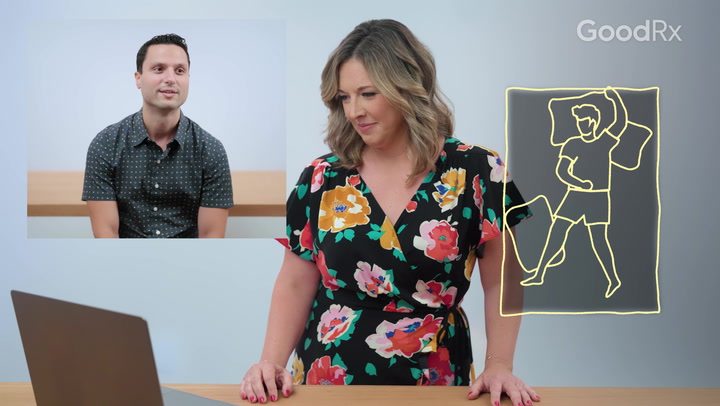
Understanding REM Sleep: How Much You Need and Why It Matters
Key takeaways:
Sleep has two main stages — rapid eye movement (REM) sleep and non-REM sleep.
REM sleep is characterized by rapid eye movements, decreased muscle tone, and increased brain activity.
REM sleep is the stage of sleep in which you dream. It’s thought to play a role in procedural learning, creativity, and emotional regulation.
You can get more REM sleep by practicing good sleep hygiene, minimizing sleep disruptions, and making sure you get 7 to 9 hours of sleep each night.
After a day of being awake and active, both your brain and body need sleep. And although sleep may seem uneventful, there’s actually a lot going on while you’re sleeping.
Humans have two main stages of sleep — rapid eye movement (REM) sleep and non-REM sleep.
What is REM sleep?
REM sleep is the stage of sleep during which dreaming usually happens. The name comes from the rapid eye movements that are observed during this phase of sleep. Researchers are still uncovering more about why and how we dream. But we do know that REM sleep is a complex and surprisingly active state.
Wise use cannabis for sleep
THC gummies made for deep, restful sleep. Clinician-led guidance always included. Use code TRYEO and get 10% off.


Must be 21 years or older to purchase. Cannabis is not recommended for women who are pregnant or nursing or those who are suffering from bipolar disorder or schizophrenia. Cannabis use may increase risk of falls. Always consult with your doctor before beginning any new medical treatment.
There are three components of REM sleep in humans:
Rapid eye movements: Your eyelids remain closed, but your eyes move around rapidly in different directions. The eyes do not send visual information to your brain, however.
Muscle atonia: During REM sleep, your arms and legs (skeletal muscles) experience a type of temporary paralysis known as muscle atonia. Researchers are still figuring out exactly how and why this happens. But it seems to be caused by changes in signals that are sent from the brain to the muscles.
Increased brain activity: During REM sleep, your brain is quite active. The level of brain activity during REM sleep is very similar to when you’re awake, but without the same level of conscious awareness.
What are the different stages of sleep?

In a typical night of sleep, you go through several sleep cycles. In each sleep cycle, you move through four stages of sleep. There are two main sleep stages: REM sleep and non-REM (NREM) sleep. NREM sleep is broken down into three distinct phases (NREM 1, 2, and 3).
Light sleep (NREM 1): This happens just after you move from wakefulness into sleep. Your breathing rate stays the same as it is while you’re awake, and your muscle tone is normal. This is the lightest and shortest sleep stage and usually lasts up to 5 minutes.
Deeper sleep (NREM 2): You start to enter deeper sleep in NREM 2, and your heart rate and body temperature drop. This is the stage during which teeth grinding tends to occur.
Deepest sleep (NREM 3): This is the deepest stage of sleep and the hardest to wake up from. During this stage, even loud sounds might not wake you up. If you are woken up during this stage, you might have some mental fogginess for the first 30 minutes or so. Even though it’s the stage of deepest sleep, sleep disturbances like sleep-walking, sleep-talking, and bedwetting tend to happen during this phase.
REM sleep: As noted above, this is actually not a “restful” phase of sleep. Most of your muscles become weak and don’t move, but your breathing muscles and eye muscles are active. Your breathing rate tends to become more irregular. This is the stage in which dreaming tends to occur.
After REM sleep, the cycle starts over again. Each cycle lasts for about 90 to 120 minutes, and most people naturally wake up after four to six sleep cycles.
The length of each sleep stage in a cycle depends on how long you have been asleep. Right after you fall asleep, your sleep cycles will mostly be non-REM sleep. (You get most of your deep sleep in the early part of the night.)
But as the night progresses, you’ll spend more time in REM sleep. After you’ve been asleep for about 6 hours, most of your sleep will be REM sleep. This is why many dreams take place in the morning.
Read more like this
Explore these related articles, suggested for readers like you.
What’s the difference between REM sleep and deep sleep?
Deep sleep occurs in the NREM 3 phase. During this time, your muscles are still functional, which is why this is the stage in which sleepwalking and sleep talking tend to happen. Contrary to popular belief, these common sleep disturbances don’t happen while you’re dreaming. This is because dreaming mostly happens during REM sleep, when your muscles can’t move, so it’s not possible to sleepwalk.
Deep sleep and REM sleep also have different functions in the body. During the deep sleep of NREM 3, your body builds muscle and bone, repairs tissues, and strengthens the immune system. During REM sleep, the brain is very active and there is increased blood flow to the brain. Many people believe that this is a critical stage for memory and learning. You can think of deep sleep as the stage that heals the body and REM sleep as the stage that restores the brain.
Why is REM sleep important?
Figuring out why REM sleep is important has been an area of active investigation for decades. Most of the benefits of REM sleep that researchers are exploring are related to brain function, since that is the part of the body most active during REM sleep. But we are still learning more about the ways REM sleep helps our body and mind. REM sleep may be helpful for:
Learning new information
Researchers think that REM sleep may be important for learning new information and skills. However, this is an area of some controversy. In animal studies, REM sleep has been shown to play a role in learning. But in human studies, the role of REM sleep in learning is less clear.
Recent studies seem to indicate that REM sleep is important for “procedural learning,” which includes things like learning a foreign language or learning morse code. When people are deprived of REM sleep, it doesn’t seem to make much difference in their ability to remember things like lists of words or facts. But it can worsen their memory for procedural tasks.
Brain development
REM sleep may support brain development. This may be one reason that children sleep more than adults and spend more time in REM sleep when they are younger. Newborn babies spend about half of their sleep time in REM. During adulthood, only about 25% of sleep is spent in REM.
Dreams
Most of our dreams (though not all) take place during REM sleep. Scientists can’t completely explain what’s happening when we’re dreaming. But some research suggests that dreaming might be important for creativity.
One study that surveyed over 1,000 people found that dreams played an important role in helping people solve problems and gain insights. Dreams even pushed them to do new things in their lives.
Better mental health
Getting enough REM sleep is important for mental health. This is because emotional processing — the complex relationship between memory and emotion — may be especially influenced by REM sleep.
That said, much of what experts know about this subject comes from animal research. So there’s still a lot to learn. Sleep scientists continue to work to understand the link between sleep and mental health.
What happens if you don’t get enough REM sleep?
What happens when you don’t get enough REM sleep is still an area of active research and more studies are needed. However, not getting enough REM sleep has been linked to a variety of problems, including:
More trouble managing your mood and emotions: Research suggests that missing out on REM sleep might lead to emotional reactivity and anxiety.
Difficulty with certain skills: You may have trouble remembering procedural skills.
Increased inflammation in the brain: Some research suggests that a lack of REM sleep can lead to increased inflammation in the brain.
Increased risk of death in adults over age 65: One study found that for older adults, every 5% decrease in REM sleep was associated with a 13% increase in mortality rate. We don’t know what causes this link, so it’s possible that less REM sleep is a marker of other health problems instead of the cause. More studies are needed to understand the role of REM sleep in aging.
How much REM sleep do you need?
The amount of REM sleep you need depends on your age and the total time spent sleeping. If you’re sleeping 7 to 9 hours per night (which is the recommended amount of sleep for a healthy adult), you need 60 to 120 minutes of REM sleep during that time.
REM sleep usually makes up about 25% of total sleep time for adults. As you get older, you tend to get less REM sleep. It may sound surprising, but there are steps you can take to get more REM sleep (more on this below).
To learn how much REM sleep you’re getting, you can try using a sleep tracker. But keep in mind that sleep trackers don’t always report your sleep stages correctly.
How can you get more REM sleep?
Since REM sleep tends to be concentrated in the second half of the night, it’s important not to skimp on morning sleep. If you wake up before you get a full 7 to 9 hours of sleep, you’re mostly missing out on the REM stage. So to get enough REM sleep, make sure you’re getting enough sleep overall and minimizing disruptions.
There are several helpful “sleep hygiene” habits that you can adopt to improve your sleep. These include:
Going to bed and waking up at the same time every day
Following a nightly bedtime routine
Avoiding caffeine and alcohol several hours before bedtime
Keeping your room cool
Keeping your bedroom dark and quiet at night
Getting exposure to sunlight in the morning
Avoiding late-night meals
The bottom line
REM sleep is a surprisingly active phase of sleep. Even though your muscles decrease in tone and don’t move during REM sleep, your brain is actively engaged. Researchers are still trying to understand the purpose and benefits of this sleep phase, during which we have most of our dreams. While REM sleep appears to be involved in procedural memory, emotional regulation, and general mental health, there is still much that we can learn about this somewhat elusive state of sleep. To make sure you’re getting enough REM sleep, get enough overall sleep and make sure to follow healthy sleep hygiene habits.
Why trust our experts?



References
American Academy of Sleep Medicine. (2020). Healthy sleep habits.
Barrett, D. (2017). Dreams and creative problem-solving. Annals of the New York Academy of Sciences.
Boyce, R., et al. (2017). REM sleep and memory. Current Opinion in Neurobiology.
Brooks, P. L., et al. (2012). Identification of the transmitter and receptor mechanisms responsible for REM sleep paralysis. Journal of Neuroscience.
Chow, H. M., et al. (2013). Rhythmic alternating patterns of brain activity distinguish rapid eye movement sleep from other states of consciousness. Proceedings of the National Academy of Sciences of the United States of America.
De Zambotti, M., et al. (2019). The sleep of the ring: Comparison of the ŌURA sleep ring tracker against polysomnography. Behavioral Sleep Medicine.
Hirshkowitz, M., et al. (2015). National Sleep Foundation’s sleep time duration recommendations: Methodology and results summary. Sleep Health.
Jiang, F. (2019). Sleep and early brain development. Annals of Nutrition and Metabolism.
Karni, A., et al. (1994). Dependence on REM sleep of overnight improvement of a perceptual skill. Science.
Krause, A. J., et al. (2017). The sleep-deprived human brain. Nature Reviews. Neuroscience.
Leary, E. B., et al. (2020). Association of rapid eye movement sleep with mortality in middle-aged and older adults. JAMA Neurology.
Mason, I. C., et al. (2022). Light exposure during sleep impairs cardiometabolic function. Proceedings of the National Academy of Sciences of the United States of America.
Mukai, Y., et al. (2023). Functional roles of REM sleep. Neuroscience Research.
National Institute of Neurological Disorders and Stroke. (2023). Brain basics: Understanding sleep.
Neuroscience. 2nd edition. (2001). The possible functions of REM sleep and dreaming. Sinauer Associates.
Ohayon, M. M., et al. (2004). Meta-analysis of quantitative sleep parameters from childhood to old age in healthy individuals: Developing normative sleep values across the human lifespan. Sleep.
Patel, A. K., et al. (2022). Physiology, sleep stages. StatPearls.
Peever, J., et al. (2017). The biology of REM sleep. Current Biology.
Rasch, B., et al. (2013). About sleep’s role in memory. Physiological Reviews.
Schredl, M., et al. (2007). Self-reported effects of dreams on waking-life creativity: An empirical study. The Journal of Psychology.
Suresh, K., et al. (2021). Impact of REM sleep deprivation and sleep recovery on circulatory neuroinflammatory markers. Sleep Science.
Tempesta, D., et al. (2018). Sleep and emotional processing. Sleep Medicine Reviews.
Trouche, S., et al. (2020). The role of sleep in emotional processing: Insights and unknowns from rodent research. Current Opinion in Physiology.





























